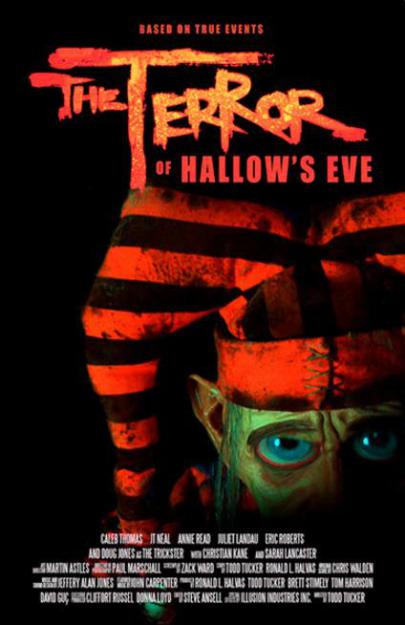
If you know your special effects, Todd Tucker needs no introduction. A legend in the field, Tucker has worked with some of the biggest names including Steven Spielberg, Francis Ford Coppola and Mel Gibson. Now the go to guy for big budget visuals has made a smaller-scale, more personal horror film about bullying. The Terror of Hallow’s Eve is a vintage, semi-autobiographical horror about escapism, revenge and giving people a damn good scare on Halloween. Hours before its world premiere, Horror Cult Films sat down with Tucker to talk about the movie, the 80s and why there’s a Timmy is all of us. I will add that, on entry, he gave us a goodie bag, complete with a t-shirt, a comic, a poster and a CD, so I was immediately endeared to him.
As your second movie as director, after Monster Mutt, it strikes me that you’re very into horror as being fun, right?
Definitely, I’m not a huge gore guy – I’m much more a creature guy. I was inspired by Halloween, Pumpkin Head, Phantasm and stuff like that – so there’s not a lot of blood for me. So I’m probably a bit more commercial in that respect. I mean I love all horror, but my style is more that way.
It’s the kind of horror you could watch with your kids – hide behind the sofa style
We didn’t want to make a gore-fest film, but we also didn’t want to make something overly sexual because the character’s based on events that happened to me as a kid. So I basically took all my memories and put them into the first half hour of the film- and that’s exactly how it happened to me as a kid. After that I wanted to literally make something that felt like those early 80s films – familiar, but new. So it was more about creating something I was passionate about and I hope that translates into the film.
I assume it was the bullying aspect rather than the make a wish aspect
(Laughs) Yeah, though I did make a wish! It just didn’t come true.
What made you want to do a film about that part of your life now?
Being a parent myself. It’s funny, because when it happened to me as a kid it was pretty traumatising but it wasn’t something I held on to for a long time. And it wasn’t until a few years ago when my daughter got into high school, and she was being bullied, that I thought about it then I was brought right back. That’s when I started coming up with the concept. So for me my goal was to make the ultimate anti bullying, 1980s horror film. But bullying is such a huge thing now because there’s so many different ways – when I was a kid it just meant some big guy came up to you and punched you, so it was physical. But now there’s so many outlets and it’s bullshit. So I wanted to come up with something that pointed to that. Now my message of the film isn’t if you’ve been bullied then summon a supernatural creature to kill your bullies – the message is that this happened to me but I didn’t let it dictate who I was and what I’d do. So if you’ve had anything similar happen then let it go – don’t let it define you.
I think that’s really interesting about the nature of bullying changing since it’s no longer about a specific time or place
It’s crazy – and really unfortunate. Because back when I was a kid we didn’t have cellphones or internet or all these avenues that people can use to bully other people. So it’s really kind of sad that it’s got to a point where technology makes it so people can bully other people so randomly and so sporadically. It’s traumatizing to people, but for those who are doing it it’s just some bored 40 year old guy in his mum’s basement bagging on stuff on the internet.

With this talk in technology, let’s get to the setting. There’s a kind of modern nostalgia for the 80s, right? I’m thinking Stranger Things and Stephen King’s It. What is it about this era?
It’s simple: late 70s gave us Star Wars, Jaws, Phantasm and Halloween – that’s kind of the catalyst. Then as soon as they 80s came in, and VHS became an option, you now had all these avenues for making films and putting them somewhere. The films themselves also hadn’t been done to death, so there was this new open venue to give filmmakers the opportunity to make their films. The problem now is that so many studio executives are involved now and it’s really hard to make what you want to make with the passion that you have in case you got guys in the next room to make you do stuff you don’t want to do or shouldn’t be doing. So the films of the 80s were inspired by the filmmakers and they hadn’t been done before. Now it’s hard not to do something that’s not been done before. So that’s the trick, and I think with people getting back into that vibe I think it’s because the movies at the time were ground-breaking and fresh.
One of the big names you just mentioned was of course Spielberg. Now you worked with him on Hook, but you also worked with Mel Gibson and Gore Verbinski. Did working with them inform your approach on the first couple of movies?
Absolutely, because when I moved to LA I had a gameplan to start off as an effects artist, start making creatures and puppeteering and then write, produce and direct my own stuff. So I had this plan and when I came down one of my first movie experiences was Hook. Now my big two directors, my main inspirations, are Steven Spielberg and John Carpenter – so when I got to work on Hook it was the most amazing thing in the world. I’d literally go on set, do my makeup then just focus on watching how he Spielberg directed, how he motivated people and how he interacted with them to get to what he was getting. And I got to work with Coppola on Dracula, so I worked with a lot of great guys – and I’d study them onset. I’m sure they thought I was stalking them, but I’d just sit there and watch what they did and what they got right, or what they didn’t, and take note of all that.
You just mentioned Carpenter, so it’s great that he did the soundtrack to this.
I reached out to his wife, sandy king, who I worked with in the past. He has two CDs out now called The Lost Themes, which he wrote and is touring. So I reached out to her and asked if she’d see if we could use his music in the film. Now I knew he doesn’t let anyone use his music, so didn’t expect it. But then a day later she calls back and says ‘yeah, you’re good to go’. I couldn’t believe it. So to have his music featured in the film was like a little kiss from God – saying this was quality enough for John to allow me to use his stuff.
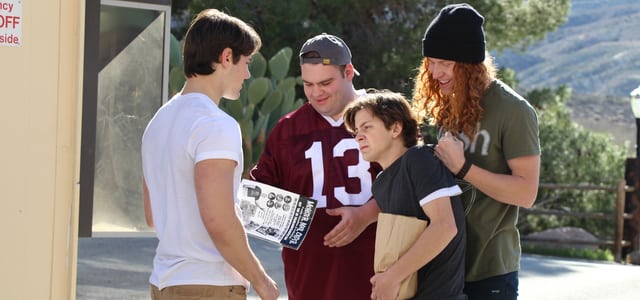
When it came to the effects, am I right in thinking that it’s CG enhancements on puppets?
Yeah, we have about a dozen different creatures in this film, and about eight or nine are puppets and the others are makeups. We wanted to do everything practically, so it has that 80s vibe, but I also wanted to utilise the technology to take it up a notch. So for The Trickster, we shot Doug Jones against a green screen and shrunk him down to 4ft and digitally made his eyes bigger. But it’s still Doug – it’s still the performance, and that’s the beautiful thing. I learned this when we were working on the Passion of the Christ, and I asked Mel to let me do the visual effects too and marry everything for the film – we did 178 visual effects shot. We just used that same design idea here to make sure the practical characters could be enhanced, but you can’t tell where the CG comes in because of this basis.
And in that respect it’s the marriage between the two
Absolutely, and it’s a beautiful marriage – but you need that practical there first.
For a lot of horror fans there’s kind of a bad name attached to CG vs pratical – I’m thinking of something physical like The Thing here.
It’s hard because horror fans respond to practical effects and horror fans will be the first to say The Thing is a lot better than the prequel because it’s all CG. And it was good CG, it wasn’t bad. It’s just the problem with CG a lot of the time, especially for characters stuff, is when it’s alive with emotion – it’s different for environments or robots. But when you create a CG character it’s very difficult at times for the audience to bond with it and they won’t even know why. It’s just not alive, it’s not there, and instinctually you can feel it. Horror fans definitely feel it. That’s why I think a lot of them are so anti CG. But when it’s used right it’s a beautiful thing.
Have you got a favourite ever monster?
The one that did the most damage to me was Michael Myers. I literally was never afraid of anything I saw until that movie and it messed me up for three years. I had horrible nightmares about Michael Myers and that’s why I got so obsessed with Carpenter. Originally this film was called The Terror of Halloween, but we decided that’s not cool – it’s stepping on John – so we changed it to Hallow’s Eve. It’s great that we got him in the mix, but it’s a film we wanted to make that would be for the fans. By putting my own story in there I hope that’d personalise it enough for me and that’d translate to the film and make people want to go ‘holy crap, I know what that kid feels like because I went through something similar’. Not the monster, but the real life bit. So I wanted to make something grounded in its story that then became a visual escapade of creatures.
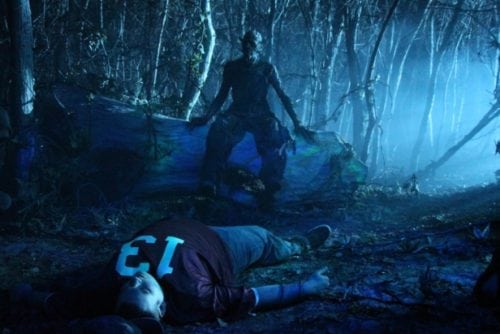
So when it enters the fantasy realm it really does
Yeah, I wanted to create a lot of texture within the film, so when the bullies get pulled into the nightmare dimensions, each dimensions has a different colour and look to it – red, green and blue tones – so that it’d make you feel like you were visually in a different place. And really create nightmare sequences that really felt like nightmares – like you’re dreaming that nightmare. There are certain things I wanted to make and just leave in the shadows, because a lot of times you have nightmares you can’t see things perfectly.
Finally, across your whole career have you got a particular effect or piece of work you’re most proud of?
I have to say it’s this. I’ve never put myself so into a project – I’m always engrossed in everything I do, but I needed to make this stand out. And the only way I thought I could do that was make it so personal to me that it translates. For me, this was such a hard story to tell, but it’s worth it because the people who have seen it, and that’s not very many, have said ‘I know Timmy – I was Timmy’. The best comment I had was from the cast and crew screening where so many people came up to me and said ‘that took me right back to my childhood’.
I expect a lot of horror fans will have been Timmy at some point.
Well horror fans are inherently a bit introverted so I hopefully wanted to tap into this and bond with the fans if that’s possible.
Thank you
As a P.S, after the movie showed he came out to do some Q&A with the audience – I can tell you now that star Caleb Thomas is 23! Now watch the trailer below and see if you can believe it.
The Terror of Hallow’s Eve is reviewed here

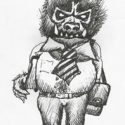
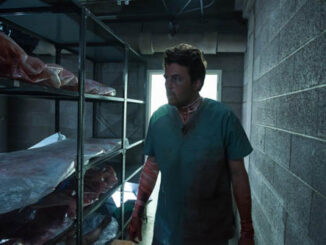


Be the first to comment